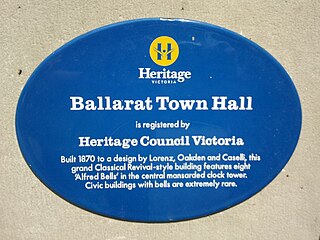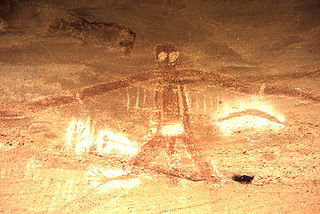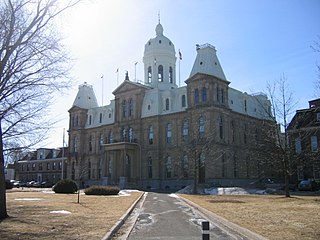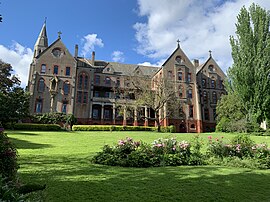
In the United Kingdom, a listed building is a structure of particular architectural and/or historic interest deserving of special protection. Such buildings are placed on one of the four statutory lists maintained by Historic England in England, Historic Environment Scotland in Scotland, Cadw in Wales, and the Northern Ireland Environment Agency in Northern Ireland. The term has also been used in the Republic of Ireland, where buildings are protected under the Planning and Development Act 2000, although the statutory term in Ireland is "protected structure".

Flinders is a seaside town on the Mornington Peninsula in Melbourne, Victoria, Australia, 73 km (45 mi) south of Melbourne's Central Business District, located within the Shire of Mornington Peninsula local government area. Flinders recorded a population of 1,130 at the 2021 census.

The National Historic Preservation Act is legislation intended to preserve historic and archaeological sites in the United States of America. The act created the National Register of Historic Places, the list of National Historic Landmarks, and the State Historic Preservation Offices.

The Ontario Heritage Act, first enacted on March 5, 1975, allows municipalities and the provincial government to designate individual properties and districts in the Canadian Province of Ontario, as being of cultural heritage value or interest.

Heritage New Zealand Pouhere Taonga is a Crown entity with a membership of around 20,000 people that advocates for the protection of ancestral sites and heritage buildings in New Zealand. It was set up through the Historic Places Act 1954 with a mission to "...promote the identification, protection, preservation and conservation of the historical and cultural heritage of New Zealand" and is an autonomous Crown entity. Its current enabling legislation is the Heritage New Zealand Pouhere Taonga Act 2014.

The Hotel Windsor is a luxury hotel in Melbourne, Victoria, Australia. Opened in 1884, the Windsor is notable for being Melbourne's only surviving purpose-built "grand" Victorian era hotel.

The Australian National Heritage List or National Heritage List (NHL) is a heritage register, a list of national heritage places deemed to be of outstanding heritage significance to Australia, established in 2003. The list includes natural and historic places, including those of cultural significance to Indigenous Australians such as Aboriginal Australian sacred sites. Having been assessed against a set list of criteria, once a place is put on the National Heritage List, the provisions of the Environment Protection and Biodiversity Conservation Act 1999 apply.
The Heritage Council of Western Australia is the Government of Western Australia agency created to identify, conserve and promote places of cultural heritage significance in the state.

Heritage Victoria is a branch of the Victorian Department of Transport and Planning. It is the regulator responsible for administering the Heritage Act 2017. The Heritage Act provides for the protection and conservation of the cultural heritage of Victoria and establishes the Victorian Heritage Register and Heritage Inventory. The Register is a list of places and objects which are of significance to the State of Victoria. The Inventory is a list of known historical archaeological sites. Both statutory lists can be searched via the Victorian Heritage Database.

The Sturt Street Gardens is a central reservation running along Sturt Street, one of the main thoroughfares of Ballarat,. The formal gardens span 13 city blocks from Grenville Street in the east to Pleasant Street in the west, are 20 metres (22 yd) wide and cover an area of 2.87 hectares running east–west.

An Australian Aboriginal sacred site is a place deemed significant and meaningful by Aboriginal Australians based on their beliefs. It may include any feature in the landscape, and in coastal areas, these may lie underwater. The site's status is derived from an association with some aspect of social and cultural tradition, which is related to ancestral beings, collectively known as Dreamtime, who created both physical and social aspects of the world. The site may have its access restricted based on gender, clan or other Aboriginal grouping, or other factors.
Australian heritage laws exist at the national (Commonwealth) level, and at each of Australian Capital Territory, New South Wales, Northern Territory, Queensland, South Australia, Tasmania, Victoria, Western Australia state and territory levels. Generally there are separate laws governing Aboriginal cultural heritage and sacred sites, and historical heritage. State laws also allow heritage to be protected through local government regulations, such as planning schemes, as well.
The Aboriginal Cultural Heritage Act 2003 is legislation passed by Queensland Parliament, commencing in April 2004 to recognise, protect and conserve Aboriginal cultural heritage in the State of Queensland

The New South Wales State Heritage Register, also known as NSW State Heritage Register, is a heritage list of places in the state of New South Wales, Australia, that are protected by New South Wales legislation, generally covered by the Heritage Act 1977 and its 2010 amendments. The register is administered by the Heritage Council of NSW via Heritage NSW, a division of the Government of New South Wales Department of Planning and Environment.

The Aboriginal and Torres Strait Islander Heritage Protection Act 1984(Cth), is an Act passed by the Parliament of the Commonwealth of Australia to enable the Commonwealth Government to intervene and, where necessary, preserve and protect areas and objects of particular significance to Australia's Aboriginal or Torres Strait Islander peoples from being desecrated or injured.

The Victoria Bridge is a bridge over the Yarra River between Richmond and Hawthorn, Melbourne, Australia. It carries Victoria Street across the Yarra.

The Heritage Conservation Act is a provincial statute which allows for the preservation of cultural heritage properties and areas in the province of New Brunswick, Canada.
The Historic Buildings Preservation Council (HBPC) was established by the Victorian state government as a statutory authority in 1974 to administer provisions of the Historic Buildings Act 1974.

Ngara was the birthplace of the 21st prime minister of Australia, Gough Whitlam. It is located at 46 Rowland Street, Kew, a suburb of Melbourne, Victoria. "Ngara" means "to listen, hear and think" in the Darug language of the Darug or Iyora (Eora) Aboriginal people in the Sydney area.
The Carlton Inn was a former pub in Carlton, Melbourne, in the Australian state of Victoria, built c. 1856. It was controversially illegally demolished without planning or heritage approval on the weekend of 15-16 October 2016.

















